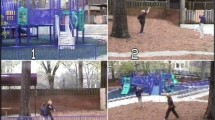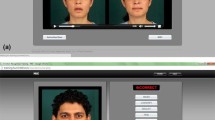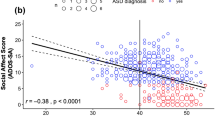Abstract
The effect of expertise training with faces was studied in adults with ASD who showed initial impairment in face recognition. Participants were randomly assigned to a computerized training program involving either faces or houses. Pre- and post-testing included standardized and experimental measures of behavior and event-related brain potentials (ERPs), as well as interviews after training. After training, all participants met behavioral criteria for expertise with the specific stimuli on which they received training. Scores on standardized measures improved after training for both groups, but only the face training group showed an increased face inversion effect behaviorally and electrophysiological changes to faces in the P100 component. These findings suggest that individuals with ASD can gain expertise in face processing through training.




Similar content being viewed by others
References
American Psychiatric Association. (1994). Diagnostic and statistical manual of mental disorders (4th ed.). Washington, DC: Author.
Balas, B., & Nelson, C. A. (2010). The role of face shape and pigmentation in other-race face perception: An electrophysiological study. Neuropsychologia, 48, 498–506.
Bentin, S., Allison, T., Puce, A., Perez, E., & McCarthy, G. (1996). Electrophysiological studies of face perception in humans. Journal of Cognitive Neuroscience, 8, 551–565.
Benton, A. L., Sivan, A. B., de Hamsher, K. S., Varney, N. R., & Spreen, O. (1983). Facial recognition: Stimulus and multiple choice pictures. New York, NY: Oxford University Press.
Bölte, S., Feineis-Matthews, S., Leber, S., Dierks, T., Hubl, D., & Poustka, F. (2002). The development and evaluation of a computer-based program to test and to teach the recognition of facial affect. International Journal of Circumpolar Health, 61, 61–68.
Bölte, S., Hubl, D., Feineis-Matthews, S., Prvulovic, D., Dierks, T., & Poustka, F. (2006). Facial affect recognition training in autism: Can we animate the fusiform gyrus? Behavioral Neuroscience, 120, 211–216.
Boutet, I., & Faubert, J. (2006). Recognition of faces and complex objects in younger and older adults. Memory and Cognition, 34, 854–864.
Deruelle, C., Rondan, C., Gepner, B., & Tardif, C. (2004). Spatial frequency and face processing in children with autism and Asperger syndrome. Journal of Autism and Developmental Disorders, 34, 199–210.
Diamond, R., & Carey, S. (1986). Why faces are and are not special: An effect of expertise. Journal of Experimental Psychology: General, 115, 107–117.
Faja, S., Aylward, E., Bernier, R., & Dawson, G. (2008). Becoming a face expert: A computerized face-training program. Developmental Neuropsychology, 33, 1–24.
Faja, S., Webb, S. J., Merkle, K., Aylward, E., & Dawson, G. (2009). Brief report: Face configuration accuracy and processing speed among adults with high-functioning autism spectrum disorders. Journal of Autism and Developmental Disorders, 39, 532–538.
Farah, M. J., Tanaka, J. W., & Drain, H. M. (1995). What causes the face inversion effect? Journal of Experimental Psychology; Human Perception and Performance, 21, 628–634.
Freire, A., & Lee, K. (2001). Face recognition in 4- to 7-year olds: Processing of configural, featural, and paraphernalia information. Journal of Experimental Child Psychology, 80, 347–371.
Gauthier, I., & Tarr, M. J. (1997). Becoming a “Greeble” expert: Exploring mechanisms for face recognition. Vision Research, 37, 1673–1682.
Gauthier, I., Williams, P., Tarr, M. J., & Tanaka, J. (1998). Training Greeble experts: A framework for studying expert object recognition processes. Vision Research, 38, 2401–2428.
Golan, O., & Baron-Cohen, S. (2006). Systemizing empathy: teaching adults with Asperger syndrome or high-functioning autism to recognize complex emotions using interactive multimedia. Development and Psychopathology, 18, 591–617.
Golan, O., Baron-Cohen, S., Ashwin, E., Granader, Y., McClintock, S., Day, K., et al. (2010). Enhancing emotion recognition in children with autism spectrum conditions: An intervention using animated vehicles with real emotional faces. Journal of Autism and Developmental Disorders, 40, 269–279.
Hobson, R. P., Ouston, J., & Lee, A. (1988). What’s in a face? The case of autism. The British Journal of Psychology, 79, 441–453.
Itier, R. J., & Taylor, M. J. (2002). Inversion and contrast polarity reversal affect both encoding and recognition processes of unfamiliar faces: A repetition study using ERPs. Neuroimage, 15, 353–372.
Itier, R. H., & Taylor, M. J. (2004). Effects of repetition learning on upright, inverted and contrast-reversed face processing using ERPs. Neuroimage, 21, 1518–1532.
Ito, T. A., & Urland, G. R. (2003). Race and gender on the brain: Electrocortical measures of attention to the race and gender of multiply categorizable individuals. Journal of Personality and Social Psychology, 85, 616–626.
Ito, T. A., Thompson, E., & Cacioppo, J. T. (2004). Tracking the timecourse of social perception: The effects of racial cues on event-related brain potentials. Personality and Social Psychology Bulletin, 30, 1267–1280.
Jemel, B., Schuller, A. M., & Goffaux, V. (2010). Characterizing the spatio-temporal dynamics of the neural events occurring prior to and up to overt recognition of famous faces. Journal of Cognitive Neuroscience, 22, 2289–2305.
Jones, W., Carr, K., & Klin, A. (2008). Absence of preferential looking to the eyes of approaching adults predicts level of social disability in 2-year-old toddlers with autism spectrum disorder. Archives of General Psychiatry, 65, 946–954.
Joseph, R. M., & Tanaka, J. (2003). Holistic and part-based face recognition in children with autism. Journal of Child Psychology and Psychiatry and Allied Disciplines, 44, 529–542.
Kleinhans, N. M., Richards, T., Sterling, L., Stegbauer, K. C., Mahurin, R., Johnson, L. C., et al. (2008). Abnormal functional connectivity in autism spectrum disorders during face processing. Brain, 131, 1000–1012.
Kleinhans, N. M., Johnson, L. C., Richards, T., Mahurin, R., Greenson, J., Dawson, G., et al. (2009). Reduced neural habituation in the amygdala and social impairments in autism spectrum disorders. American Journal of Psychiatry, 166, 467–475.
Klin, A., Jones, W., Schultz, R., Volkmar, F., & Cohen, D. (2002). Visual fixation patterns during viewing of naturalistic social situations as predictors of social competence in individuals with autism. Archives of General Psychiatry, 59, 809–816.
Klinger, L. G., & Dawson, G. (2001). Prototype formation in autism. Developmental Psychopathology, 13, 111–124.
Lahaie, A., Mottron, L., Arguin, M., Berthiaume, C., Jemel, B., & Saumier, D. (2006). Face perception in high-functioning autistic adults: Evidence for superior processing of face parts, not for a configural face-processing deficit. Neuropsychology, 20, 30–41.
Langdell, T. (1978). Recognition of faces: An approach to the study of autism. Journal of Child Psychology and Psychiatry and Allied Disciplines, 19, 255–268.
Lord, C., Rutter, M., & LeCouteur, A. (1994). Autism Diagnostic Interview-Revised: A revised version of a diagnostic interview for caregivers of individuals with possible pervasive developmental disorders. Journal of Autism and Developmental Disorders, 24, 659–685.
Lord, C., Risi, S., Lambrecht, L., Cook, E. H., Jr., Leventhal, B. L., DiLavore, P. C., et al. (2000). The Autism Diagnostic Observation Schedule–Generic: A standard measure of social and communication deficits associated with the spectrum of autism. Journal of Autism and Developmental Disorders, 30, 205–223.
McKone, E., & Boyer, B. L. (2006). Sensitivity of 4-year-olds to featural and second-order relational changes in face distinctiveness. Journal of Experimental Child Psychology, 94, 134–162.
McKone, E., Kanwisher, N., & Duchaine, B. C. (2007). Can generic expertise explain special processing for faces? Trends in Cognitive Sciences, 11, 8–15.
McPartland, J., Dawson, G., Webb, S., Panagiotides, H., & Carver, L. (2004). Event-related brain potentials reveal anomalies in temporal processing of faces in autism spectrum disorder. Journal of Child Psychology and Psychiatry, 45, 1235–1245.
Mondloch, C. J., Le Grand, R., & Maurer, D. (2002). Configural face processing develops more slowly than featural face processing. Perception, 31, 553–566.
Nishimura, M., Rutherford, M. D., & Maurer, D. (2008). Converging evidence of configural processing of faces in high-functioning adults with autism spectrum disorders. Visual Cognition, 16, 859–891.
O’Connor, K., Hamm, J. P., & Kirk, I. J. (2007). Neurophysiological responses to face, facial regions and objects in adults with Asperger’s syndrome: An ERP investigation. International Journal of Psychophysiology, 63, 283–293.
Pellicano, E., & Rhodes, G. (2003). Holistic processing of faces in preschool children and adults. Psychological Science, 14, 618–622.
Pelphrey, K. A., Sasson, N. J., Reznick, J. S., Paul, G., Goldman, B. D., & Piven, J. (2002). Visual scanning of faces in autism. Journal of Autism and Develomental Disorders, 32, 249–261.
Rose, F. E., Lincoln, A. J., Lai, Z., Ene, M., Searcy, Y. M., & Bellugi, U. (2007). Orientation and affective expression effects on face recognition in Williams syndrome and autism. Journal of Autism and Developmental Disorders, 37, 513–522.
Rossion, B., Delvenne, J. F., Debatisse, D., Goffaux, V., Bruyer, R., Crommelinck, M., et al. (1999). Spatio-temporal localization of the face inversion effect: an event-related potentials study. Biological Psychology, 50, 173–189.
Rossion, B., Gauthier, I., Goffaux, V., Tarr, M. J., & Crommelinck, M. (2002). Exertise training with novel objects leads to left-lateralized facelike electrophysiological responses. Psychological Science, 13, 250–257.
Rutherford, M. D., & McIntosh, D. N. (2007). Rules versus prototype matching: strategies of perception of emotional facial expressions in the autism spectrum. Journal of Autism and Developmental Disorders, 37, 187–196.
Schweinberger, S. R., Pickering, E. C., Jentzsch, I., Burton, A. M., & Kaufmann, J. M. (2002). Event-related brain potential evidence for a response of inferior temporal cortex to familiar face repetitions. Brain Research Cognitive Brain Research, 14, 398–409.
Schweinberger, S. R., Huddy, V., & Burton, A. M. (2004). N250r: A face-selective brain response to stimulus repetitions. NeuroReport, 15, 1501–1505.
Scott, L. S., Tanaka, J. W., Sheinberg, D. L., & Curran, T. (2006). A reevaluation of the electrophysiological correlates of expert object processing. Journal of Cognitive Neuroscience, 18, 1453–1465.
Scott, L. S., Tanaka, J. W., Sheinberg, D. L., & Curran, T. (2008). The role of category learning in the acquisition and retention of perceptual expertise: a behavioral and neurophysiological study. Brain Research, 1210, 204–215.
Silver, M., & Oakes, P. (2001). Evaluation of a new computer intervention to teach people with autism or Asperger syndrome to recognize and predict emotions in others. Autism, 5, 299–316.
Stahl, J., Wiese, H., & Schweinberger, S. R. (2008). Expertise and own-race bias in face processing: An event-related potential study. NeuroReport, 19, 583–587.
Sterling, L., Dawson, G., Webb, S. J., Murias, M., Munson, J., Panagiotides, H., et al. (2008). The role of face familiarity in eye tracking of faces by individuals with autism spectrum disorders. Journal of Autism and Developmental Disorders, 38, 1666–1675.
Tanaka, J. W., & Farah, M. J. (1993). Parts and wholes in face recognition. Quarterly Journal of Experimental Psychology, 46, 225–245.
Tanaka, J. W., & Sengco, J. A. (1997). Features and their configuration in face recognition. Memory & Cognition, 25, 583–592.
Tanaka, J. W., & Taylor, M. (1991). Object categories and expertise: Is the basic level in the eye of the beholder? Cognitive Psychology, 23, 457–482.
Tanaka, J. W., Curran, T., Porterfield, A. L., & Collins, D. (2006). Activation of preexisting and acquired face representations: the N250 event-related potential as an index of face familiarity. Journal of Cognitive Neuroscience, 18, 1488–1497.
Tanaka, J. W., Wolf, J. M., Klaiman, C., Koenig, K., Cockburn, J., Herlihy, L., et al. (2010). Using computerized games to teach face recognition skills to children with autism spectrum disorder: The Let’s Face It! program. Journal of Child Psychology and Psychiatry, 51, 944–952.
Taylor, M. J., Batty, M., & Itier, R. J. (2004). The faces of development: A review of early face processing over childhood. Journal of Cognitive Neuroscience, 16, 1426–1442.
Teunisse, J. P., & de Gelder, B. (2003). Face processing in adolescents with autistic disorder: The inversion and composite effects. Brain and Cognition, 52, 285–294.
Tottenham, N., Tanaka, J., Leon, A. C., McCarry, T., Nurse, M., Hare, T. A., et al. (2009). The NimStim set of facial expressions: Judgments from untrained research participants. Psychiatry Research, 168, 242–249.
Wallace, S., Coleman, M., & Bailey, A. (2008). Face and object processing in autism spectrum disorders. Autism, 1, 43–51.
Webb, S. J., Jones, E. J. H., Merkle, K., Murias, M., Greenson, J., Richards, T., et al. (2010a). Response to familiar faces, newly familiar faces, and novel faces as assessed by ERPs is intact in adults with autism spectrum disorders. International Journal of Psychophysiology, 77, 106–117.
Webb, S. J., Jones, E. J. H., Merkle, K., Nankung, J., Toth, K., Greenson, J., et al. (2010b). Toddlers with elevated autism symptoms show slowed habituation to faces. Child Neuropsychology, 16, 255–278.
Webb, S. J., Merkle, K., Murias, M., Richards, T., Aylward, E., & Dawson, G. (2009). ERP responses differentiate inverted but not upright face processing in adults with ASD. Social Cognitive and Affective Neuroscience. doi:10.1093/scan/nsp002.
Wechsler, D. (1997a). Wechsler adult intelligence scale (3rd ed.). San Antonio, TX: The Psychological Corporation.
Wechsler, D. (1997b). Wechsler memory scale (3rd ed.). San Antonio, TX: The Psychological Corporation.
Wiese, H., Schweinberger, S. R., & Hansen, K. (2008). The age of the beholder: ERP evidence of an own-age bias in face memory. Neuropsychologia, 46, 2973–2985.
Yin, R. K. (1969). Looking at upside-down faces. Journal of Experimental Psychology, 81, 141–145.
Young, A. W., Hellawell, D., & Hay, D. C. (1987). Configural information in face perception. Perception, 16, 747–759.
Acknowledgments
This project was supported by the NIMH STAART (Dawson/Aylward U54 MH066399), the NICHD Autism Center of Excellence (Webb P50 HD055782), NINDS Postdoctoral Award (Faja T32NS007413), Autism Speaks Postdoctoral Fellowship (Jones), the UW Mary Gates Fellowship (Kamara), Dr. Jessica Greenson and the STAART Diagnostic Core, and the UW Psychophysiology and Behavioral Systems Lab. The project is the sole responsibility of the authors and does not necessarily reflect the views of the funding agencies. Some stimuli were from the MacBrain Face Stimulus Set (John D. & Catherine T. MacArthur Foundation Research Network on Early Experience & Brain Development), Dr. Nancy Kanwiser (houses), and Dr. Martin Eimer (houses). We especially thank the participants and their families. These data were presented at the International Meeting for Autism Research, London, UK, in May, 2008.
Author information
Authors and Affiliations
Corresponding author
Rights and permissions
About this article
Cite this article
Faja, S., Webb, S.J., Jones, E. et al. The Effects of Face Expertise Training on the Behavioral Performance and Brain Activity of Adults with High Functioning Autism Spectrum Disorders. J Autism Dev Disord 42, 278–293 (2012). https://doi.org/10.1007/s10803-011-1243-8
Published:
Issue Date:
DOI: https://doi.org/10.1007/s10803-011-1243-8




